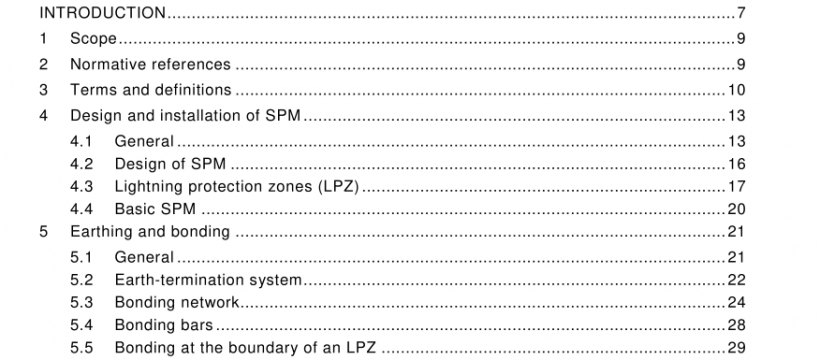IEC 62305-4:2010 pdf free download
IEC 62305-4:2010 pdf free download.Protection against lightning
6.1 General
Magnetic shielding can reduce the electromagnetic field as well as the magnitude of induced internal surges. Suitable routing of internal lines can also minimize the magnitude of induced internal surges. Both measures are effective in reducing permanent failure of internal systems.
6.2 Spatial shielding
Spatial shields define protected zones, which may cover the whole structure, a part of it, a single room or the equipment enclosure only. These may be grid-like, or continuous metal shields, or comprise the “natural components” of the structure itself (see IEC 62305-3). Spatial shields are advisable where it is more practical and useful to protect a defined zone of the structure instead of several individual pieces of equipment. Spatial shields should be provided in the early planning stage of a new structure or a new internal system. Retrofitting to existing installations may result in higher costs and greater technical difficulties.
6.3 Shielding of internal lines
Shielding may be restricted to cabling and equipment of the system to be protected; metallic shield of cables, closed metallic cable ducts and metallic enclosures of equipment are used for this purpose.
6.4 Routing of internal lines
Suitable routing of internal lines minimizes induction loops and reduces the creation of surge voltages internally in the structure. The loop area can be minimized by routing the cables close to natural components of the structure which have been earthed and/or by routing electrical and signal lines together.
6.5 Shielding of external
lines Shielding of external lines entering the structure includes cable shields, closed metallic cable ducts and concrete cable ducts with interconnected reinforcement steel. Shielding of external lines is helpful, but often not the responsibility of the SPM planner (since the owner of external lines is normally the network provider).
The protection of internal systems against surges requires a systematic approach consisting of coordinated SPDs for both power and signal lines. The rules for the selection and installation of a coordinated SPD system are similar in both cases (see Annex C).
IEC 62305-4:2010 pdf free download
